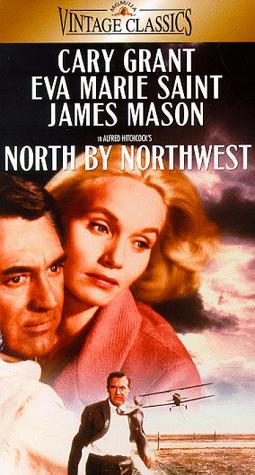 Study
Questions: Week Four
Study
Questions: Week Four  Study
Questions: Week Four
Study
Questions: Week Four
On the Run and Heading for Easy Street
North by Northwest (1959)
The Killing (1956)
In addition to appropriating the technical innovations of the Hollywood film during the 1950s, Hitchcock also drew on the sociopolitical concerns of the era. The Cold War offered settings for many films about international intrigue, and Hitchcock made good use of this popular film genre. His two best films, however, used the Cold War as background for his familiar subjects and themes such as mistaken identity, characters pursued for no apparent reasons, the malign nature of governmental powers, and the problematic nature of romantic love and conjugal life. His two films more explicitly about the conflict between East and West, and Torn Curtain (1966) Topaz (1969), are decidedly inferior efforts.
Stanley Kubrick's films, with a few exceptions, are variations on the major Hollywood film genres. Of his first five feature films, two were film noir Killer's Kiss, 1955 and The Killing, 1956; two were war films (Fear and Desire, 1953 and Paths of Glory, 1957), and one was was from a sub-genre that enjoyed popularity during the 1950s: the biblical epic (Spartacus, 1960). He went on to science fiction (2001, 1968), the historical romance (Barry Lyndon, 1975), horror (The Shining, 1980) and another war film (Full Metal Jacket, 1987). Even films which are not easily identified with a major genre regularly employ their conventions Lolita (1962) borrows from the road film; Dr. Strangelove (1964) draws on the war narrative; A Clockwork Orange (1971) uses the futuristic setting of science fiction. Kubrick, however, never just reworks familiar narrative patterns; he transforms those patterns into films which express his very personal view of life.
North by Northwest: Mistaken Identities.
1. In what ways does North reflect Hitchcock's turning away from plots and circumstances rooted in family/domestic conflicts to one rooted in Cold War politics?
2. To what degree does the power of this film depend on memorable sequences rather than on a strongly integrated narrative?
3. What do you make of the relationship between Thornhill and his mother? How is it both similar to and different from the mother/son relationship in previous films.
4. How does Hitchcock treat the U.S. Intelligence Agency and its leaders? How do they treat US citizens? Are we, the audience encouraged to admire or condemn?
5. Is the whole "Kaplan" business, which drives the plot from episode to episode a real exploration of the world of espionage? Or is the whole spy business a McGuffin, an excuse to explore the themes of guilt, mistaken identity, and dread that are familiar in Hitchcock's other films? To put it another way, is Cold War politics here analogous to Freudian psychology in Psycho?
6. What is the meaning of the title? How is it related to the action and themes of the film?
7. This film is famous for two episodes: the attack of the crop-dusting airplane and the chase across the faces carved into Mt. Rushmore. What about them seems to attract so much admiration? How do they both create tension by defamiliarizing the normal and commonplace?
8. Is there anything you find disturbing in Hitchcock's love scenes, anything which suggests his ambivalence toward the erotic and the sexual?
9. Does Hitchcock make fun of his hero and even of the thriller as a genre? In what ways might North be an ironic comment on the directors favorite themes and character types?
10. In what ways is Eva Marie Saint an embodiment of the Hitchcock heroine?
The Killing: After today, We'll Be on Easy Street.
1. Why does Kubrick use the elaborate narrative structure of flashbacks and parallel plots? How does it help point up the contrast between the elegance of the plans for the robbery with the traps and missteps of actual events?
2. How many elements of the noir style can you find in the use of visual imagery, the motifs of traps and betrayals, the fate of the protagonists, the construction of the various characters?
3. How does Kubrick give his characters a sense of individuality by using flashbacks to give biographical information?
4. How do the motives for taking part in the robbery set the members of Johnny's crew apart from the typical gangster?
5. How are women presented in the film? Are they individualized, or do they pretty much reflect familiar stereotypes?
6. How do human instincts (especially love and sex) serve to frustrate intellect and reason in this film?
7. What is the purpose of the racial outburst in the race track parking lot? Does it serve for more than a diversion to allow Nikki to do his job?
8. How effective is the voice over in this film? How does the cold, clear newsreel style of the voice seem at cross-purposes with the chaos at the end of the film?
9. How does Sherry's lover serve as Johnny Clay's nemesis?
10. Why does Johnny let Sherry go after catching her eavesdropping? What flaw in Johnny's character is revealed in this scene?
11. What small, unanticipated events threaten the success of Johnny's plan?
12. What is the significance of the film's title (which Kubrick changed while adapting the novel)? Does it have more than one meaning? Sherry's dying comment is that her life has been "a bad joke without a punch line." Johnny's reaction to the failure of his plan is "what's the difference." How do these bitter statements tend to sum up the world view of the film noir?